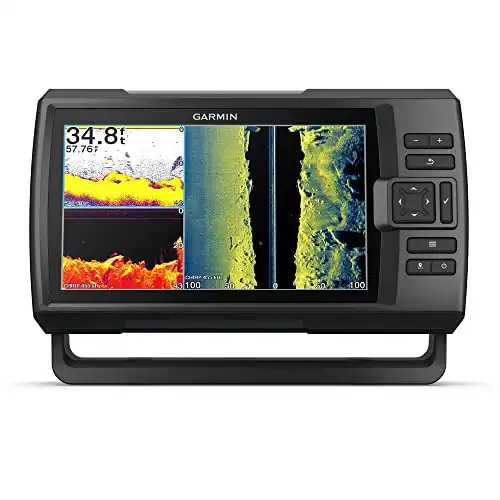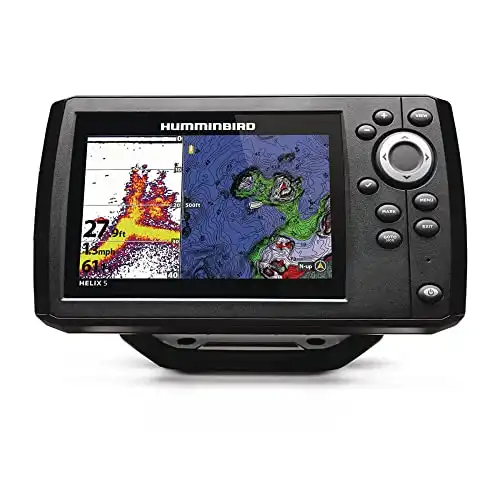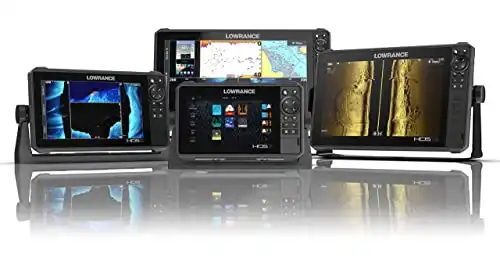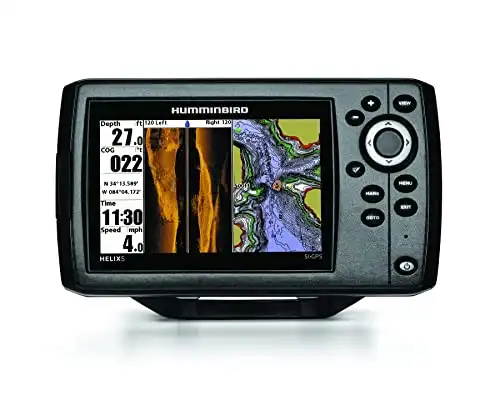
Do you want to find the best side imaging fish finder?
We’ve rounded up a list of the best side imaging fish finders, and we’re going to tell you everything you need to know about them. Side Imaging vs Down Imaging – what is it? What are the benefits of each type of sonar technology? How do I choose the right one for my application and the species I am targeting? All your questions will be answered here!
You can read all about which MFD’s made our list in this article. It includes pros and cons, as well as a detailed description of how they work so that you can make an informed decision when purchasing your next fish finder. Don’t miss out on this great opportunity! The information in this article could save you hundreds or even thousands of dollars by helping you avoid buying a product that doesn’t meet your needs.
Check out our top picks below, then keep scrolling for the detailed reviews of the best side imaging fish finders on the market today.
Sonar-Standard, dual spectrum CHIRP technology with MEGA down imagine and MEGA side imagining offer tremendous fish locating capabilities.
The Striker Plus 9V is a strong contender, almost earning the top spot in our reviews due to its lower price with competitive features.
With a built-in base map, the Helix 5 is ready to fish as soon as you open the box.
Simultaneous CHIRP Sonar with StructureScan 3D high definition imaging offers the best possible view of fish and underwater structure.
This is a slighter older model than those previously reviewed, first introduced in 2014, but it has its strengths and a cadre of enthusiastic anglers who support it.
Wider sonar coverage with wide-angle CHIRP sonar, creating an acoustic cone that covers nearly twice the area of competing models makes this a favorite for anglers on the Great Lakes and other expansive bodies of water.
Side Imaging vs. Down Imaging
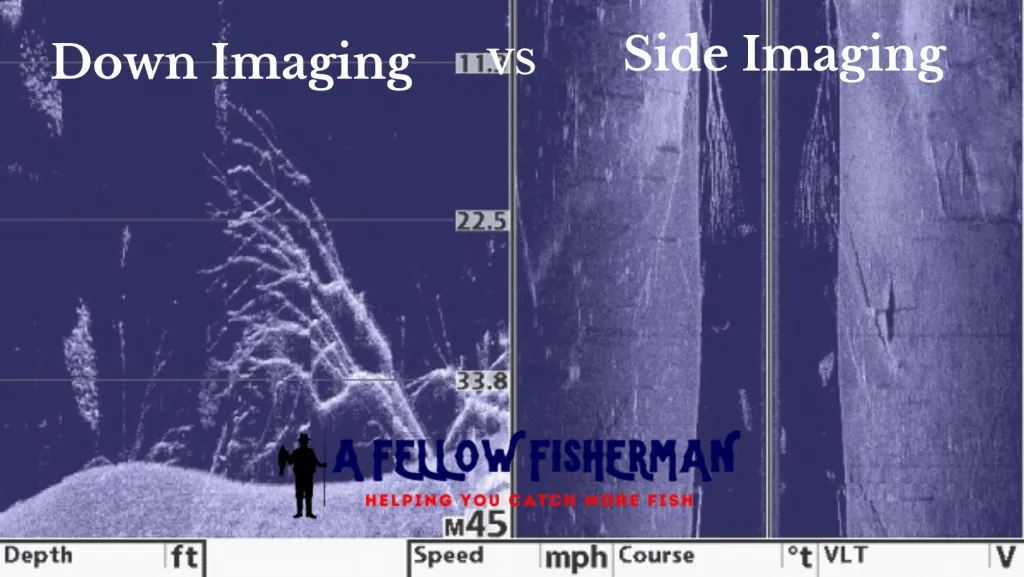
The terminology associated with fish finders can be a bit confusing. There are two emerging technologies that both produce great imaging under your boat, but that produce very different images that need to be interpreted differently as well.
The two technologies are referred as down and side imaging.
The function of both fits their descriptive names pretty well.
Down imaging sonar is the sending of a sonar signal straight down below your boat. This technology returns an image of anything under your vessel and can take amazingly clear images at even high speeds on the water.
Side imaging also known as side-scanning is, as it sounds, images taken from both sides of your boat as it passes by on the surface.
Side scans can reveal greater detail since the signals shoot out and away from your boat, but there is a caveat when using a side imaging transducer you can’t go very fast.
What is the Best Side Imaging Fish Finder?
Down scan fish finders have been around for almost 75 years. Side imaging systems are a much more recent innovation, with Humminbird producing the first consumer market version in 2005.
With less than two decades of consumer use, the side imaging transducer has caught on with a wide variety of anglers and has its positive and negative features when compared to a down scan system.
On the positive side, you have double the sonar imaging taking place. Side imaging transducers send sonar beams at right angles to the path of your boat.
The dual beam transducer emits dual signal sonar beams approximately 100-yards on each side of the boat.
Side imaging transducers don’t penetrate as deep as down imaging fish finders do. The depths are still impressive, and you’ll have to be in a very deep lake, or on the edge of the continental shelf to utilize deeper images.
Depending on the fish finder manufacturers, side imaging transducers work well from 240 to 450 feet (0.14 km) underwater.
Another advantage is better performance by side imaging fish finders in shallow water. This makes the side imaging technique favored by bass anglers, and anyone working the shallow stretches of saltwater off the Gulf Coast.
Perspective is an added benefit to side imaging as well, with juxtaposed images 180 degrees from each other this allows an angler to cover up to 600 feet of submerged terrain as the boat slowly passes by.
The primary disadvantage is scanning imagery reduces as speed increases. Anything faster than a mid-speed troll makes a side imaging scanner ineffective.
That means on a new lake, you can’t map the underwater contours nearly as quickly as you can with a down imaging fish finder.
What Are the Qualities We’ll Compare in Determining the Best Side Imaging Fish Finders?
The biggest factor for most anglers in finding the best side imaging fish finder is the cost. These devices are substantially more expensive than their down scan cousins. You can easily spend a couple of thousand dollars or more getting a side imaging fish finder with all the options included.
The second consideration is the quality of the image as measured by resolution. The higher the resolution the better the image.
Additional qualities to consider are the depth the device can reach, how easy it is to read in bright daylight, and in the opposite direction, just how well you can see it at night.
Battery life, weight, footprint, and ease of mounting are also considerations.
Best Side Imaging Fish Finders Reviewed
It’s probably no surprise that the company that invented the side imaging fish finder gets the top nod for the best side imager. The Humminbird HELIX 7 CHIRP MEGA Side Imaging Fish Finder gets the top pick as the best side finder on the market for cost, features, reliability, and durability.
1. Humminbird HELIX 7 CHIRP MEGA Side Imaging Fish Finder
The MSI acronym in the device’s name indicates it is side imaging, “MEGA side imaging” in Humminbird’s product description.
The Helix 7 comes in four configurations with a starting price of around $700, two with down imaging technology and the other two with side imaging technology.
The Helix 7 CHIRP MSI GPS G3 and the Helix 7 CHIRP MSI GPS G3 NAV.
A seven-inch screen, with buttons rather than a touch screen interface, enhances durability on the water. The heavy-duty button interface is built to withstand the often savage conditions of salt, sun, and sand in saltwater applications.
The high-resolution TFT display has 800 horizontal and 480 vertical lines of resolution.
The side imaging technology is designed to deliver high-definition images up to 125 feet (ca. 38 m) away from your boat on both sides.
A low-power, dual spectrum CHIRP transducer offers a pair of imaging modes. The wide setting searches a wide area for fish and structure, while the narrow mode offers enhanced imaging for maximum quality of detail.
The dual beam transducer, power cable, mounting bracket, and mounting hardware are all included in the basic package.
The fish finder has a power input range of 10.8 to 20 volts DC, which offers great power protection with often fickle marine batteries that are known to have wide power ranges.
Humminbird includes their proprietary software that has detailed contour images of over 10,000 US lakes and coastal areas of the Atlantic and Pacific with this fish finder. You can create and store your own maps with Humminbird’s AutoChart Live software that takes the images you retrieve from the water you’re on and stores it in the Helix 7 for future retrieval.
2. Garmin STRIKER Plus 9sv
Garmin is the leading competitor with Humminbird for fish finders, whether they’re down imaging or side imaging.
The Striker Plus 9V is a strong contender, almost earning the top spot in our reviews due to its lower price with competitive features.
The nine-inch high-definition screen is a prominent feature of the Garmin 9VS.
The dual beam transducer utilizes Garmin’s CHIRP traditional sonar imaging technology, plus CHIRP ClearVu and CHIRP SideVu scanning sonars.
A built-in mapping feature uses Garmin’s proprietary Quickdraw Contour mapping software allows you to create and store maps with contours of one foot that cover up to two million acres. This feature allows you to return time and time again to your favorite lake and to quickly locate the best fishing spots you’ve discovered on former trips.
The nine-inch display features a bright, sunlight-readable interface that works even on the brightest, sunlit afternoons.
Built-in Wi-Fi access allows you to receive notifications and easily upgrade your device to the latest software.
The included GPS interfaces with your maps can create the shortest routes to your favorite fishing spots and delivers real-time readings of your boat’s speed and location.
Power cables, data cable, tilt mount, transom and trolling motor mounts and a four-pin to eight-pin adapter cable are all standard accessories included with the basic package.
3. Humminbird HELIX 5 CHIRP SI GPS G2 Fish Finder
Every Humminbird fish finder comes with its outstanding contour mapping software. Combine this mapping feature with the stored contour images of over 10,000 lakes along with the Pacific Coast, the Eastern Seaboard, and the Gulf Coast, and there aren’t many bodies of water you can’t locate yourself on exactly.
This mapping option interfaces seamlessly with the onboard GPS system included in the Helix 5.
The dual-beam sonar technology allows detailed imagery at greater depths than competing models.
The Helix 5 is an older model with great features, available at a lower price than more recent side imaging fish finders.
A five-inch screen, transom mounting hardware, internal GPS, and Humminbird’s rigorous push-button controls make this device a great choice for saltwater and freshwater applications.
4. Lowrance HDS-Live Fish Finder
Lowrance enters our best side imaging fish finders list with a slightly higher price device than those offered above by Humminbird and Garmin.
The HDS-Live Fish Finder weighs in just shy of nine pounds. Its 12.6 x 9.06 x 9.84 footprint is larger than competing models but the packed options in this device take a little extra space.
Simultaneous CHIRP Sonar with StructureScan 3D high definition imaging offers the best possible view of fish and underwater structure.
The side imaging software delivers crisp, clear views on both sides of your boat as you slowly troll up a lake, or cruise offshore a few hundred yards from the beach.
The color sonar map clearly displayed on the seven-inch screen is among the best available on the market.
A dual-core processor offers faster speed and quicker redrawing of maps. This means a quicker response time when you load a map or when creating your own maps.
The easy routing feature allows you to navigate to your favorite fishing spot utilizing the built-in GPS software with the stored maps.
This option requires C-MAP, MAX-N + charts, Navionics+ or Navionics Platinum charts.
5. Humminbird Helix 5 SI Fish Finder with Side-Imaging and GPS
This is a slighter older model than those previously reviewed, first introduced in 2014, but it has its strengths and a cadre of enthusiastic anglers who support it.
This fish finder weighs just 4.14 pounds (1.88 kg) and has a tiny 8.5 × 6 x 4-inch footprint.
The five-inch screen creates, clear, readable images.
The Helix 5 features a dual AC/DC power feature for use on larger boats with AC converters onboard.
The smaller size is unique for this class of fish finders, making it a great choice for canoes, kayaks, and smaller flat-bottomed boats.
GPS chart plotting interface with the included UniMap cartography software is stored on a micro SD card.
The screen offers a 256 color display with 800 horizontal and 480 vertical lines of resolution.
This is a model on the verge of obsolescence in the face of more modern technology, but its size, versatility, and established use on the market allow it to compete well.
The huge fan base that supports this product speaks for itself.
6. Lowrance HOOK2
Our final product review features a fish finder with a wide variety of screen sizes. The HOOK 2 comes with screen sizes of five, seven, nine, and 12-inches. The price difference in the various screen sizes reflects the cost of creating high-definition visual images from sound waves.
A TripleShot transducer with installed inland United States lakes provides intricate detail in locating your favorite fishing spots.
Wider sonar coverage with wide-angle CHIRP sonar technology, creating an acoustic cone that covers nearly twice the area of competing models, makes this a favorite for anglers on the Great Lakes and other expansive bodies of water.
The 9 × 7.5 × 7.13-inch footprint offers easy mounting on watercraft of various sizes. The HOOK 2 is a favorite for kayaks, canoes, and even float tube anglers.
The preloaded Lowrance software offers detailed maps of 4,000 American lakes.
The sonar reaches depths of 300 feet (ca. 91 m), with side scanning ranges also at 300 feet (ca. 91 m) on both sides of the boat.
Easy setup with the included transom or trolling motor mounting hardware makes it easy to transfer this fish finder from one boat to another.
An added feature is the ability to upgrade the software and to store map images on a standard SD card.
Conclusion

The first question to ask yourself when you’re about to shell out some substantial cash for a fish finder is how this will improve your chances of taking a limit or hooking that once-in-a-lifetime lunker you’ve been searching for.
A side scanning fish finder gives you greater detail, and if you’re apt to find yourself in shallow water, it is a major improvement over its down imaging competitors.
The other considerations are the pre-loaded contour maps that are available with many models versus the quicker coverage of down imaging software when searching new lakes or offshore areas.
A side scanning fish finder can give you an edge if time or distance is a major consideration. In most applications a down imaging device works just fine, but if you have a special circumstance, and a little more free cash to spend, a fish finder is a great addition to your angling arsenal.
Finding the best side imaging fish finders doesn’t have to be a challenge. Review the features, weigh the cost against the benefits, and you’ll make the right decision for your unique angling adventures.
For more guidance on choosing your next fish finder, check out the pages below:
- Best Fish Finder GPS Combo | How to Choose
- 7 Best Fish Finder GPS Combo’s Under $1000
- Best Fish Finder For Catching More Bass
- Best Fish Finders for Kayaks
- Best Fish Finder for Shallow Water
- The 5 Best Fish Finders Under $500
- The Best Ice Fishing Fish Finders and Flashers
- The Best Portable Fish Finders | Reviews & Buyers Guide
- Best Fish Finders By Category


